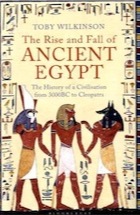Wilkinson takes a bit of a different view of pharaonic society than that given in many books. That is, he does not glorify the Pharaohs, but speaks instead of their despotic qualities. In some ways I think his portrayal is a bit too reactionary in his effort not to glorify the Pharaohs. Of course the Pharaohs were autocrats, but the real picture is almost always more nuanced than an either/or scenario. I will say that he becomes a bit less scathing in his discussion of later (New Kingdom and later) Pharaohs. Perhaps this is in part because he seems to have done more work on the Early Dynastic period and therefore is more intimately familiar with them, leading him to also be more critical of the rulers of that period. They were a bit more ruthless then, seeing as human sacrifice and the killing and burying of the household with the Pharaoh were still practised then. His dim view of them, then, isn't entirely unjustified, though I think a more nuanced view would be best.
On the other hand, I thought he allowed too much of the sensationalism around the Amarna period to seep in. For example, he still gives the speculation that Tutankhamun may have been murdered. While there isn't a definitive explanation of his death yet, the general consensus is that it was an accidental death due to an infected broken leg and malaria. I do understand his inclusion of this, for it is difficult not to fall prey to the sensationalism that often surrounds the Amarna period. Tutankhamun has captured the public imagination, and speculation is often rife. When writing a book marketed to the general public and not just to academics, it is understandable to include a bit of sensationalism.
The most infuriating thing for me was a short sentence in the epilogue: "the deep wellspring of ancient Egyptian religion proved a fertile source for the development of early Christianity: for Isis and Horus, substitute Virgin and Child - the iconography (and much of the underlying theology) remained virtually identical". Other than the depiction of mother and infant for both Isis and Horus and the Blessed Virgin Mary and Jesus, I don't see overwhelming similarities either in iconography or theology. Horus' was not a virgin birth, and Mary is not a goddess. Isis did flee with Horus to protect him from Seth, so a parallel could perhaps be made to the flight into Egypt by the Holy Family, though the circumstances are different. The mother-child pairing is a universal human experience, so the prevalence of mother-infant dyads in religious art across various religions really isn't surprising. That being said, this does not necessarily indicate that the theology is the same, since the rest of the Isis/Horus myth is not all that analogous to orthodox Christian belief.
Now that I've gotten my criticisms out of the way, I hope that I've not given an impression that I disliked the book. Far from it. In fact, I'll say that overall this book is well-done. It is wonderful to have a book that gives a more detailed overview of Egyptian pharaonic history. The colour plates and numerous black-and-white photos included are invaluable in picturing the people and monuments, or recalling them to mind if one is already familiar with them. I also quite enjoyed Wilkinson's dry sense of humour that permeates the narrative. For those who know something of ancient Egypt and wish to have an overview of all of pharaonic history, this is a good book. The list of sources is also invaluable.

No comments:
Post a Comment